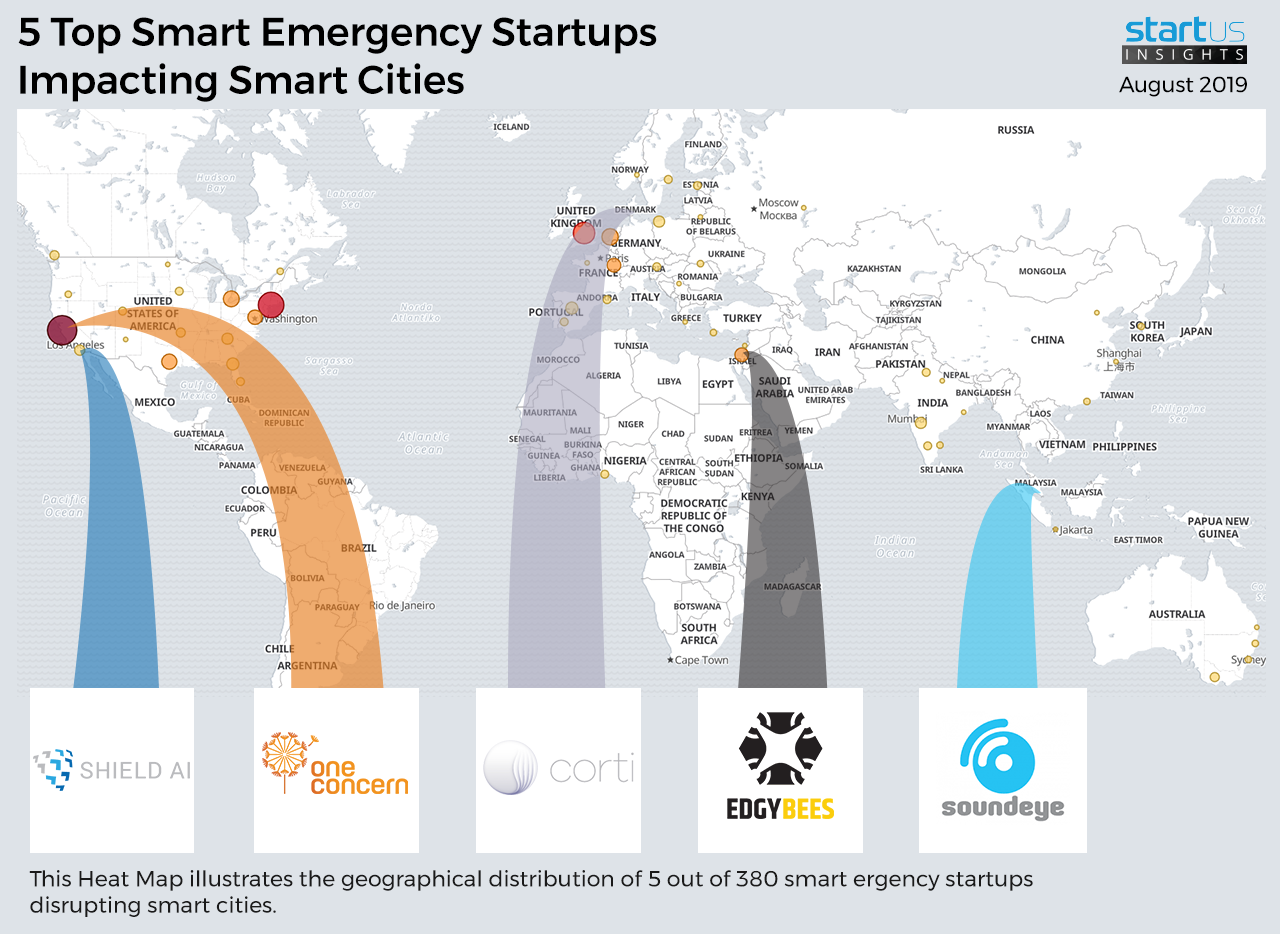Our Innovation Analysts recently looked into emerging technologies and up-and-coming startups working on solutions for Smart Cities. As there is a large number of startups working on a wide variety of solutions, we decided to share our insights with you. This time, we are taking a look at 5 promising Smart Emergency startups.
Heat Map: 5 Top Smart Emergency Startups
For our 5 top picks, we used a data-driven startup scouting approach to identify the most relevant solutions globally. The Global Startup Heat Map below highlights 5 interesting examples out of 380 relevant solutions. Depending on your specific needs, your top picks might look entirely different.
SoundEye – Abnormal Sound Recognition
In many cases, an emergency occurs before somebody notices it. Sound recognition technology, powered by Artificial Intelligence (AI) detects abnormal sounds like crying babies, gunshots, water leaking and the sound of fire crackling. By reporting it directly to first responders or building security, it significantly lowers the response time for emergencies. Singapore-based startup SoundEye develops an AI platform with deep learning-sound recognition technology for smart cities. Their technology allows relevant authorities to recognize a person screaming, independent of which language they speak. Within a building, their solution monitors abnormal air conditioning, humidity, and temperature.
One Concern – Natural Disaster Predictive Analytics
Local authorities and first responders have to manage for unforeseen natural disasters, which cause complex problems for a city. Machine learning technology allows them to predict what will happen in the immediate aftermath of a natural disaster. In the case of earthquakes, first responders will know where to conduct rescue missions and who needs the most help. It also allows them to construct disaster relief shelters before calamities take place. The US-based startup One Concern develops a platform to predict natural disasters that helps first responders and local authorities in emergency and risk management by using layers of complex data and drawing relationships between numerous data points to map the impact of natural disasters.
Corti AI – Emergency Decision Making Support
Emergency medical dispatchers fail to identify approximately 25% of cases of out of hospital cardiac arrests, thus losing the opportunity to provide instructions in cardiopulmonary resuscitation. A machine learning framework, that is trained on pre-recorded calls can perform better than emergency medical dispatchers for identifying out-of-hospital cardiac arrest via emergency phone calls. Danish startup Corti AI develops an AI-powered decision-making system, that listens in on emergency calls and uses Triage to help dispatchers detect severe cases. With Corti, dispatchers are able to reduce the number of undetected out-of-hospital cardiac arrests.
ShieldAI – Autonomous Aerial Robot
In emergency situations, it can be difficult to mobilize medical assistance for urgent rescues. By capturing a large area and getting to hard to reach places, robot-drones are helping first responders deliver better first-aid. Nova, an AI-powered aerial robot created by the US-based startup Shield, is capable of both autonomous outdoor and indoor intelligence, surveillance, and reconnaissance operations. Nova can self-direct to explore buildings, fly in the dark, navigate the dense urban environments, and areas without GPS. Their solution produces better mission outcomes and significantly reduces the risk for operators.
EDGYBEES – Augmented Reality Situational Awareness
When it comes to situational awareness, first responders are having a hard time systemizing data from video surveillance, citizen-created footage of emergency situations, and other resources. Augmented Reality (AR) situational awareness empowers first responders to understand any emergency operational scene instantly with real-time collaborative visual intelligence technology. Israeli startup EDGYBEES augments live video feeds, captured from any camera, human input or other data sources with geo-information layers including maps, building layouts, points of interest, user-generated markers, and other data layers that enhance operational intelligence during an emergency.
What About The Other 375 Solutions?
While we believe data is key to creating insights it can be easy to be overwhelmed by it. Our ambition is to create a comprehensive overview and provide actionable innovation intelligence for your Proof of Concept (PoC), partnership, or investment targets. The 5 startups showcased above are promising examples out of 380 we analyzed for this article. To identify the most relevant solutions based on your specific criteria and collaboration strategy, get in touch.









